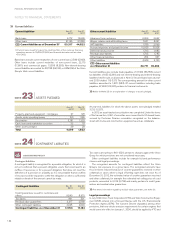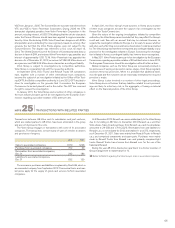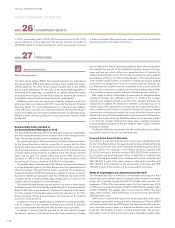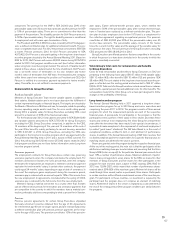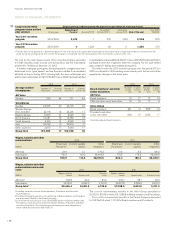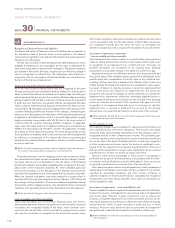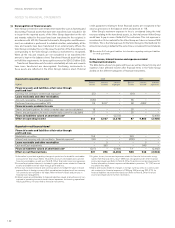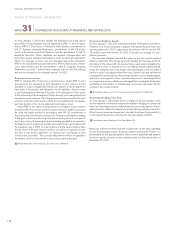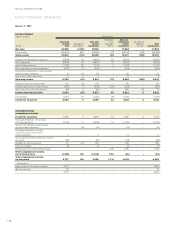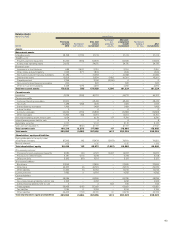Volvo 2012 Annual Report Download - page 145
Download and view the complete annual report
Please find page 145 of the 2012 Volvo annual report below. You can navigate through the pages in the report by either clicking on the pages listed below, or by using the keyword search tool below to find specific information within the annual report.
Hedge accounting
In accordance with IAS 39, derivatives used for the hedging of forecast
electricity consumption have been recognized at fair value in the balance
sheet. During 2012, Volvo applied hedge accounting for these financial
instruments. Unrealized gains and losses from fluctuations in the fair value
are debited or credited to a separate component in other comprehensive
income to the extent the requirements for cash-flow hedge accounting are
fulfilled. Accumulated changes in the value of the hedging instruments are
recognized in profit and loss at the same time as the underlying hedged
transaction affects the Group’s earnings. The table Changes in other
reserves in Note 19, Equity and number of shares disclose how the electric-
ity consumption reserve has changed during the year. When cash-flow
hedge accounting is applied for previously entered financial instruments
utilized to hedge electricity consumption, Volvo tests for effectiveness.
Hedging is considered to be effective when the forecast factors that impact
the electricity price agree with forecasts of future electricity consumption
and the designated hedging instruments. The hedging relationship is regu-
larly tested up until its maturity date. If the identified relationships are no
longer deemed effective, the price fluctuations on the hedging instrument
from the last period the instrument was considered effective are recognized
in the Volvo Group’s operating income.
During 2012, Volvo Group has applied hedge accounting for financial
instruments used to hedge interest and currency risks on loans only for
cases when hedge accounting requirements are fulfilled. The changes in
the fair value of the hedge instruments outstanding and the changes in
the carrying amount of the loan are recognized in profit and loss. For
cases where hedge accounting is not considered to be fulfilled, unrealized
gains and losses up until the maturity date of the financial instrument will
be recognized in net financial items in profit and loss.
In previous years, Volvo Group has applied hedge accounting for certain
net investments in foreign operations. The ongoing result of such hedges is
recognized as a separate item in other comprehensive income. In the event
of a divestment, the accumulated result from the hedge is recognized in
profit and loss.
Refer to page 143 for supplementary information on hedge accounting and to
Note 4 for information regarding Goals and policies in financial risk management.
Information regarding carrying amounts and fair values
In the table below, carrying amounts are compared with fair values for all
of the Volvo Group’s financial instruments.
Dec 31, 2012 Dec 31, 2011
SEK M Carrying
value Fair
value Carrying
value Fair
value
Assets
Financial assets at fair value through profit and loss1
The Volvo Group's outstanding currency riskderivatives - commercial exposure Note 16 146 146 107 107
The Volvo Group's outstanding raw materials derivatives Note 16 23 23 68 68
The Volvo Group's outstanding interest and currencyriskderivatives
– financial exposure Note 16 3,525 3,525 3,215 3,215
B/S Marketable securities Note 18 3,130 3,130 6,862 6,862
6,824 6,824 10,252 10,252
Loans receivable and other receivables
B/S Accounts receivable Note 16 27,349 – 27,699 –
Customer financing receivables2Note 15 80,989 – 78,699 –
Other interest-bearing receivables Note 16 1,291 – 564 –
109,629 – 106,962 –
Financial assets available for sale1
Holding of sharesin listed companies Note 5 347 347 635 635
Holding of sharesin non-listed companies Note 5 498 – 555 –
845 347 1,190 635
B/S Cash and cash equivalents Note 18 25,759 25,759 30,379 30,379
Liabilities Note 22
Financial liabilities at fair value through profit and loss1
The Volvo Group'scommodityderivatives - commercial exposure 5 5 279 279
The Volvo Group's outstanding raw materials derivatives 84 84 134 134
The Volvo Group's outstanding interest and currency riskderivatives
– financial exposure32,827 2,827 4,341 4,323
2,916 2,916 4,754 4,736
Financial liabilities valued at amortized cost
Long term bond loans and other loans 79,592 85,060 84,286 90,174
Short term bank loans and other loans 50,274 49,455 43,159 41,884
129,866 134,515 127,445 132,058
B/S Trade Payables 47,364 – 56,788 –
1 IFRS 7 classifies financial instruments based on the degree that market values
have been utilized when measuring fair value. All financial instruments measured
at fair value held by Volvo are classified as level 2 with the exception of shares and
participations, which are classified as level 1 for listed instruments and level 3 for
unlisted instruments. Refer to Note 5 for more information regarding valuation
principles. None of these individual shareholdings is of significant value for Volvo.
2 Volvo does not estimate the risk premium for the customer financing receivables
and chooses therefore not to disclose fair value for this category.
3 Includes a fair value of a loan related to hedge accounting neg 1,495 (neg
1,285), netted against the derivative used to hedge the risk pos 1,477 (1,267).
For further information on hedging of currency and interest rate risks on loans
see page 143.
141





